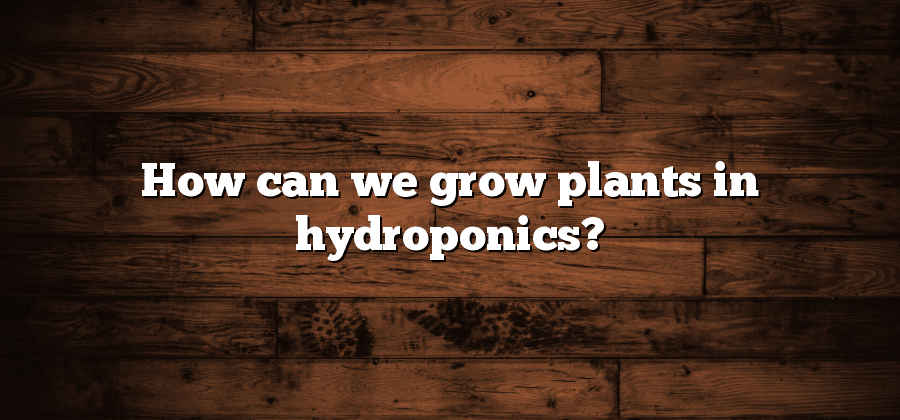Benefits of Hydroponics
Hydroponics, also known as soilless farming, offers numerous benefits that set it apart from traditional soil-based cultivation methods. One of the key advantages is the ability to grow plants in a controlled environment, free from the limitations imposed by soil quality. By providing essential nutrients directly to the plant roots via a nutrient-rich solution, hydroponics allows for faster and more efficient uptake, resulting in enhanced plant growth and larger yields. This method also conserves water, with studies showing that hydroponics uses up to 90% less water compared to conventional farming. Additionally, the absence of soil greatly reduces the risk of pests and diseases, minimizing the need for pesticides and providing a safer and healthier environment for both growers and consumers.
Another significant benefit of hydroponics is its versatility. Unlike traditional farming, hydroponics enables plants to be grown anywhere, regardless of the external conditions. This makes it an ideal option for urban areas or regions with limited access to fertile land. Hydroponic systems can be set up in small spaces, such as homes, greenhouses, or even commercial buildings, allowing individuals and businesses to grow fresh produce year-round. Furthermore, the controlled environment in hydroponics allows for precise adjustments of temperature, light, humidity, and nutrient levels, providing optimal growing conditions tailored to the specific requirements of different plant species. This versatility opens up possibilities for cultivating a wide variety of crops, from leafy greens and herbs to fruits and flowers, expanding the opportunities for farmers and consumers alike.
Types of Hydroponic Systems
Hydroponics, a soilless method of growing plants, offers several advantages over traditional gardening. One of the key elements of a successful hydroponic setup is choosing the right system. Several types of hydroponic systems are available, each with its own unique characteristics and benefits.
The **NFT (Nutrient Film Technique)** system is widely used due to its simplicity and efficiency. In this system, a thin film of nutrient-rich water flows through a sloping channel, allowing the plant roots to absorb the necessary nutrients. This method ensures that the plant’s roots receive a constant supply of oxygen, leading to faster growth and higher yields.
Another popular system is the **Deep Water Culture (DWC)**. In this setup, plants are suspended in a nutrient solution, and their roots are completely submerged in the solution, providing a rich oxygen supply. This system is easy to set up and is particularly suitable for growing leafy greens and herbs.
The **Drip Irrigation** system, on the other hand, delivers nutrient-rich water directly to the plant’s root zone through a drip line. This method allows for precise control over the amount of water and nutrients delivered to each plant, making it ideal for larger operations.
These are just a few examples of the numerous hydroponic systems available. When selecting a system, it’s important to consider factors such as the available space, plant selection, and desired level of automation. By choosing the right system for your specific needs, you can maximize the benefits of hydroponics and enjoy healthy, thriving plants.
Choosing the Right Plants for Hydroponics
When it comes to choosing the right plants for hydroponics, several factors should be considered. The first and foremost is understanding the specific requirements of the plants you wish to grow. Each plant has its own unique needs in terms of nutrient levels, pH balance, and lighting conditions. It is crucial to research and select plants that are known to thrive in a hydroponic system.
Another key consideration is the size of the plants and the space available in your hydroponic setup. Some plants can grow quite large and require ample room to spread out their roots. Others, such as leafy greens or herbs, are more compact and can be planted closer together. Understanding the growth habits of your chosen plants will help determine the appropriate spacing and overall layout of your hydroponic system. Additionally, taking into account factors such as temperature and humidity requirements will also play a role in selecting the right plants for your hydroponic garden.
By carefully selecting plants that are well-suited for hydroponic cultivation and ensuring they receive the necessary care and conditions, you can maximize the potential of your hydroponic system and enjoy a successful and fruitful harvest. The next step is to learn about setting up a hydroponic system, where we will explore the various components and steps involved in creating an efficient and productive environment for your plants to thrive.
Setting Up a Hydroponic System
To successfully set up a hydroponic system, it is essential to carefully plan and prepare for the venture. The first step is to select a suitable location for your hydroponic system. This location should have adequate space, access to electricity and water, and proper ventilation. Additionally, it is crucial to consider factors such as temperature, humidity, and lighting requirements for your chosen plants.
Once you have identified the ideal location, the next step is to choose the right equipment for your hydroponic setup. This includes selecting the appropriate type of hydroponic system, such as nutrient film technique (NFT), deep water culture (DWC), or ebb and flow. Each system has its own advantages and considerations, so it is important to research and understand which one aligns best with your goals and resources. Additionally, invest in high-quality components like pumps, grow trays, and air stones to ensure optimal performance and longevity of your hydroponic system.






